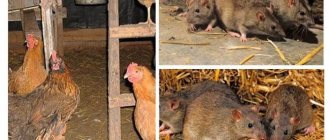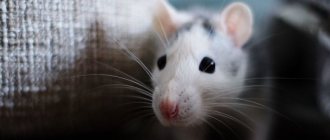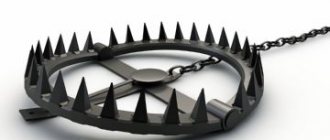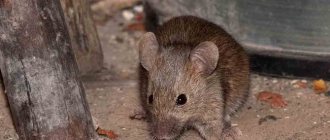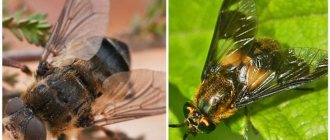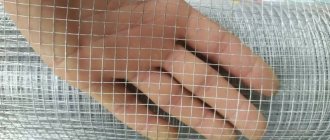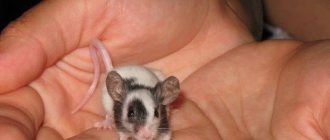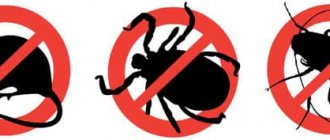Rodent droppings Not every person is able to determine that a room is infested with mice or rats. And given the secretive lifestyle of nimble rodents, it is not always possible to determine their presence in the house by the appearance of a rat or mouse. After all, they go out in search of food exclusively at night. You can make sure that rats live in the house by looking at torn bags and damaged food. However, there is another simple and most striking sign indicating the presence of pests in the house - rat droppings.
Which doctor should I contact?
If, after a rodent bite or suspected contact with its waste products (contaminated soil, water, food, air), you develop signs of an acute infectious disease (fever, headache, weakness, muscle and joint pain), as well as pain and redness in the area bite, you need to consult an infectious disease doctor.
Additionally, the wound may need to be treated by a surgeon. Rats and mice belong to the order Rodents. If you don’t know the difference between them, it’s easy to confuse the animals. This will lead to an erroneous choice of means of destruction. Adults are characterized by different sizes: a rat is larger than a mouse. At the initial stage of development, young animals are more difficult to distinguish. To understand who is found in the house, they first study the features of the rodent’s body structure.
Small animals of several species are found in residential buildings. A house mouse lives near a person, as well as a gray, black or red rat.
The difference between rodents becomes noticeable if we evaluate each body parameter separately:
Dimensions. When thinking about what ordinary rats look like, the image of a large-bodied animal immediately comes to mind. The body length of this rodent reaches 30 cm. The mouse is smaller in size, the average individual is characterized by a length of up to 10 cm. Weight. Given the difference in size, it is logical to assume that the mass of animals also differs. For example, a mouse weighs between 30 and 50 g, while a fellow rat family reaches 900 g. Tail. Differs in length and thickness. This part of the mouse's body is shorter
You should also pay attention to the thickness. The mouse has a thin tail, while large rodents have a thick tail, which is more noticeable at the base
In addition, it is not covered with fur. The mouse tail is also different: it is hairy, and the color matches the color of the body. The eyes of the mouse are larger. Rodent ears also vary in size, shape and location. For example, in a mouse they are round, wide, and directed to the sides. Rat ears are flattened and distinguished by a small base. The shape of the head is also different. The muzzle of a rat is elongated, while that of a mouse is triangular in shape.
Relative to the head, the rat's eyes are small. Mice have more expressive and slightly convex black eyes.
In addition, pay attention to the wool. There are other differences besides color.
The rat is characterized by hard hair, and the mouse has softer hair.
Rats, unlike mice, are able to jump high - up to 2 meters in extreme situations. They are highly intelligent
Differences between a mouse and a rat
The main feature of a newborn rat pup is its larger body size. This is noticeable upon birth. The mouse is always smaller. The main characteristic differences between rodents are the same as in adults: the shape of the ears, the color of the emerging fur, etc. Sometimes a baby rat is confused with an adult mouse.
To avoid this mistake, you should find out how they differ:
- A rat at an early stage of development is characterized by a blunt snout, while a mouse has a pointed head shape.
- The baby rat's tail has not yet developed enough, which means it is shorter than that of an adult mouse.
- The ears of baby rats are still small and smaller in size than the hearing organs of adult mice.
- There are still skin folds on the soles of the baby rats, while they are absent in the mice. This feature allows you to determine the difference from rodent tracks.
A distinctive feature of rat pups is their blunt-nosed, as if chopped off muzzle.
Baby rats and adult mice have similar paw sizes, but the placement of the toes is an additional characteristic that can be used to distinguish rodents.
What does rodent droppings look like?
Fresh, slightly shiny and moist feces of gnawing animals have a fairly soft consistency. Its color varies depending on the food consumed by the pest, but in most cases it is dark in color. During the hot season, it quickly dries out and hardens. Over time, the stool becomes duller, taking on a gray tint. They can easily crumble under mechanical stress.
Based on the volume of detected animal feces, you can approximately determine the number of pests living in the house. Fresh rat or mouse excrement indicates the presence of even one gnawing animal in the room. If the detected secretions are of different sizes, then this confirms the presence of an entire population of dangerous animals of various ages that are actively reproducing and growing. Large deposits of fecal matter are usually found near food supplies or along animal routes.
Such symptoms of the presence of rodents are very often observed in basement or attic-type rooms. Having discovered them, it is necessary to urgently take action or go to. Mammals are capable of reproducing very quickly, which reduces the effectiveness of independent attempts to get rid of them. Therefore, the most effective way to control pests in this case is to completely treat the premises with special professional pest control services.
Rats are quite dangerous animals for humans. They are carriers of various diseases that have a serious impact on human health. In addition, rodents have sharp teeth, which causes them to damage furniture. Their numbers are increasing at a rapid rate, so when rodents are discovered, you should immediately begin to fight them.
Rodents often live in residential areas
How to get rid of rats in an apartment? First of all, don't panic. These pests can be driven out forever; for this it is necessary to use special control methods.
Rats can appear on any floor. Concrete walls, wooden partitions or metal fences are not an obstacle for them. Thanks to their sharp teeth, in a short time they turn a small hole in the wall or a small chip into a convenient passage for themselves. They move to the upper floors through ventilation shafts, the space between pipes or garbage chutes.
Most often, rodents live in apartments that are dirty and where garbage has not been removed for a long time. They are attracted by an unpleasant smell and quickly find its source. Therefore, it is necessary to regularly take out the trash and wash the floors in the room. You can notice the presence of pests by certain signs:
- an unpleasant smell appears in the room, like a hamster;
- feces appear - these are small, dark, shiny balls;
- in the evening, night and morning in silence you can hear a strong grinding and squeaking sound;
- in houses you can see scraps of thread, paper or newspapers - these are kind of burrows, they may indicate that the rat is preparing to become a mother;
- holes appear in the walls in rooms, bathrooms and other rooms;
- the bags containing the cereal were chewed through, the contents spilled out.
Rats can go without food or water for a long time. They jump perfectly, crawl in hard-to-reach places, and swim. They are very tenacious, capable of living in unfavorable conditions for a long time, even radiation does not kill them. Sometimes they form flocks and attack humans. Therefore, if there are rats in the room, you should not put off exterminating them.
Steps
Determine how serious your problem is
- Pay attention to sudden movements.
- Pay attention to rustling and scratching sounds.
Mice easily detect themselves at night when the house is quiet. You may hear light scratching, rustling, stomping of small paws, and squeaking.
- If you hear mice running along the walls, then most likely you have more than one mouse.
If you hear squeaking, then you may have a whole brood in your house.
- Look for mouse droppings.
Mice droppings look like small oblong grains. Fresh mouse droppings will be moist and black in color, while old mouse droppings will be dried out and light gray in color.
- Pay attention to which room you found mouse droppings in and think about what might be in it that attracts your uninvited guests.
Droppings may also indicate that there are cracks or holes somewhere in the room through which mice can enter.
- Look for a mouse nest.
You will probably find it in the same area where you found the droppings. Mice usually make their nests in closets or closets. Also look in places where mice have not been disturbed for a long time.
- Mice use cardboard and clothing for their nests. So check out that pile of clothes that you've been meaning to throw away for so long and left in the closet.
Also, a musty smell may indicate that there is a mouse nest somewhere nearby.
Mice are smart animals and are not easy to see during the day, especially when there are a lot of people around. You may catch a small movement somewhere in the corner of your room out of the corner of your eye and not even realize that it was a mouse. So the next time you notice something like this, try to figure out what's going on.
How to catch mice
- Use mouse traps that trap the entire mouse and remain alive.
These traps contain bait, such as peanut butter or cheese, that will attract mice with its scent. The mouse gets there, but can’t get back out. Once the mouse is caught, you can take it to a park or forest and release it into the wild.
- Install them in the room where you find mouse droppings or nests. They can be expensive, so buy one or two of these mousetraps to start.
If you have a lot of mice in your house, then such traps are unlikely to be practical, since you will probably have to go into the forest several times in order to release the mice.
- Use sticky mousetraps.
These types of traps look like little cardboard houses. Their bottom is covered with a sticky substance that attracts mice, and to which they then stick with their paws. The traps are thrown away with the mice inside.
- Buy several of these mouse traps and place them in a room where you have seen mouse droppings or found a mouse nest. Don't forget to place them in your closets and closets.
Some traps can catch several mice.
- Mice do not die immediately in these traps, and unfortunately you can hear them squeak in pain and fear when caught in them. Keep this in mind when you are thinking about what kind of mousetrap you want to buy.
- Use a classic mousetrap.
The classic mousetrap uses peanut butter or cheese bait. When the mouse puts its paws on the trap to eat the bait, then the spring is activated, pressing the mouse with a metal bracket.
- These traps are cheap, so you can buy several at a time and place them wherever mice are likely to appear. To make cleaning easier later, place a piece of newspaper under each mousetrap.
Because these traps kill mice immediately, they are more humane than sticky traps. However, you might be less happy about throwing them away. After you discard the trap, disinfect the area where it was placed.
- Get yourself a cat or cat.
They are excellent mouse hunters and will replace any trap for you. Leave the cat in the room where you saw the mouse, and after a while you will get rid of this problem.
- You can also borrow a cat from your friends for this purpose.
The presence of a cat can deter mice and prevent them from getting into your home.
What to do to prevent mice from coming back
- Give your house a good cleaning.
Clean every nook and cranny and get rid of anything that mice might use as a nest. Throw away old boxes, bags, books, magazines, unwanted clothes, etc.
- Disinfect any areas where you find mouse droppings, nests, or where a mouse is trapped.
Do not place cardboard boxes of items on the floor, as mice can chew through them.
- Put things in order, especially in those corners of your house or apartment where you rarely look.
- Throw away anything that could be mouse food.
Mice will eat anything that can be eaten and that can be found on the floor, in kitchen cabinets, and in pantries.
- If you have nuts or berries growing near your house, then sweep them away with a rake as often as possible.
Clean up spilled food under bird feeders several times a week.
- If you keep trash in trash cans, make sure to close the lids tightly.
- Clean up leftover food after your pets. Keep their bowl empty and clean between feedings.
- Store food correctly.
Keep cereals, nuts, and other dry foods in tightly closed plastic, glass, or metal containers.
- If, for example, you used half a pack of some cereal, then pour the remaining cereal into an airtight container.
Don't leave bread or fruit on the counter for more than a day or two.
- Clean out your pantries and cabinets frequently. Try to keep your kitchen floor free of any leftover food.
- Close gaps between the floor and doors.
Close all gaps between the floor and doors to rooms. You can buy the necessary material at construction stores.
- Keep windows closed or place screens on them.
Caulk any cracks or holes in the walls, especially exterior walls. Caulk them with steel wool. This is a cheap material that will repel mice.
- Sprinkle baby powder in areas where mice might run. If a mouse runs across the powder, you can track its nest.
- If mice do not fall into your traps, try placing them in other places.
What to do if there is a rat
If a person suspects that a rat has appeared in the apartment, then he should first of all pay attention to whether there is rat excrement on the floor in the rooms, as well as an unpleasant odor. If fears are confirmed, then do not panic; the following measures should be taken:
- First of all, consult with SES employees and notify the management company about the problem.
- What to do with rats in the basement should be decided by the management company's employees. When deciding to use toxic substances, it is necessary to notify all residents of the house, who will take measures to prevent rodents from entering the apartments.
- In big cities, special means are used to kill rats that mummify the animal. Such an animal does not emit an unpleasant odor after death, thereby not scaring away other individuals. Therefore, the drug is very effective in the fight against rats.
If rats appear in the house, you should immediately begin to destroy them. In this case, you should not panic, you need to act quickly.
How to treat?
Putting off seeing a doctor, hoping for results from traditional methods, is a serious risk. The result of such a decision can be a significant deterioration in the patient’s condition, including failure of internal organs, extensive internal bleeding and death. Moreover, the medical institution will offer comprehensive treatment aimed at eliminating the symptoms and causes of the pathology:
- intravenous injections of ribavirin;
- administration of saline and glucose solution to restore basic functions and nutrition of the body;
- a course of multivitamins;
- blood transfusion, eliminating the consequences of its infection with the pathogen.
A therapeutic diet with the complete exclusion of hot and spicy foods, alcohol, vinegar and seasonings can speed up recovery.
How did I know that these were rodents after all?
Before I saw the mouse moving around the perimeter of the room, I used to suspect that someone besides me lived in the house.
A number of signs indicated this:
- Chewed food and things
. This is easy to see, the main thing is to conduct a thorough inspection of the house. Before handling suspicious objects with traces, you must wear gloves. Two imprints remain from the teeth of mice and look like two parallel holes with superficial grooves. - Excrement
. Mouse ones look like grains, rat ones look like piles of different sizes. If such an unpleasant thing is found, it is necessary to immediately begin its destruction! - Spots
. Rodents, as a rule, move along the same paths, so-called paths along the same route. Rubbing wool and floor surfaces leaves stains. By following these spots, you can easily find the “den” of pests. - Paths
. Clearly visible on dusty surfaces. From them you can determine who settled at home and the number of such guests. - Rodent corpses
. They simply cannot appear in the house. This means that a whole troop of animals has settled somewhere. - A specific odor similar to ammonia
. A rather dubious sign, but if there are other indicators of rodents, then you should sound the alarm - whiskered-tailed pests have indeed taken up residence in the house.
How to find out the presence of rodents in a room?
Rodents, especially mice, love to settle and live near humans because they:
- Very cunning and smart;
- They don’t want to bother themselves too much looking for food.
Apartments and houses where people live are usually full of delicious edible products. In order to get easy food, they follow people everywhere. They are found on trains, on ships, on airplanes and in other food supply points.
Mice can easily:
- Gnaw the walls;
- Doors;
- And sometimes they pass through ventilation systems.
The owner of a living space may not immediately notice the presence of mice and rodents. If at night you hear squeaking, rustling sounds and there are chewed objects, then we can assume that uninvited tailed guests have already settled in the apartment. After eating food, a mouse leaves traces of its presence - excrement in the form of black grains. In spring and summer, mice can move outside, but still prefer to live near humans.
Mice are usually nocturnal, but there are also cases (for example, a pregnant female) when they run around during the day in search of food and even attack people and animals. During the breeding season, the female mouse becomes very aggressive and attacks any attempt to enter her nest.
The biggest problem is the rapid reproduction of rodents. The female's pregnancy lasts no more than a month. A newborn female mouse will begin to leave offspring at the age of two months.
Prevention methods
Infections within rodent populations respond quickly to favorable weather conditions, for example, heavy rainfall or high air temperatures can increase the likelihood of the development and spread of zoonotic infections in Eastern European and Mediterranean countries. However, the increase in incidence is also associated with a number of other factors that can reduce the risk of infection among the population:
- compliance with epidemiological rules;
- regular sanitary and technical measures to combat rodents;
- disinfection of premises;
- preventing the entry of rats and mice into food warehouses, granaries and other facilities;
- high-quality water purification;
- health education for all segments of the population.
Prevention
To avoid problems and the need to treat infections, it is better not to neglect prevention. It consists of carrying out measures to exterminate rodents, disinfect premises, and comply with sanitary and hygienic standards. It is also required to periodically inspect granaries and warehouses where food supplies are stored to detect and eliminate pests as soon as possible.
Do not neglect the basic rules - wash your hands before eating and after returning from the street, pour boiling water over vegetables and fruits purchased at the market, do not eat questionable specimens and do not drink suspicious water. Check your pet mice for infections before purchasing and examine your pets.
What does rat droppings look like? Mouse droppings are dangerous Rat feces
Rat feces differ from the excrement of other rodents not only in size and shape, but also in location. Thus, the presence of brown animals is indicated by spindle-shaped droppings that lie in small piles. It has a grayish tint and fairly large particles. Very thin, about 10 mm long and almost black feces are left by black pests. The largest are the excrements of the pasyuk (gray rat), they reach a length of up to 20 mm. Below you can see what rat droppings look like in the photo.
If you notice that something foreign has gotten into your food, including mouse feces, then it is better to get rid of such food. I can't imagine anyone eating stool. And if you didn’t notice and accidentally ate poop, then nothing may happen (if these are, for example, house mice that have undergone a veterinary examination) until the most terrible infections with a fatal outcome.
Rat droppings not only cause negative emotions in people - they are very dangerous. Therefore, you should not allow this type of rodent to appear in your apartment.
Rat droppings
Even a relatively young rat will have significantly larger and thicker droppings than a mouse. What does rat droppings look like in color format? The color of rat feces also depends on the food they eat. But most often it is black with various shades. So the pellets of rat droppings differ from mouse droppings in both color and size. If you find feces on the floor in the morning that are larger than 6 mm and dark, it means that you have rats in your house. If they are light and less than 6 mm, then they are mice.
Virus transmission
Voles and Norway rats act as carriers of the virus. At the same time, animals themselves do not get sick, but only transmit this virus. It is excreted through the urine and feces of animals. Among the routes of infection, several types are distinguished:
- Airborne dust type of infection, in which dust containing excrement with the virus is inhaled;
- An alimentary type of infection in which food or water contaminated with secretions containing the virus is consumed;
- A contact type of infection in which damaged skin comes into contact with contaminated objects with the virus or directly with rodents infected with it.
The virus is not transmitted from one person to another.
How are pathogens transmitted?
Even if a person has never been bitten by a mouse, this does not mean that he is out of the risk zone. The variety of ways in which disease can be transmitted from mice is truly amazing.
You can become infected in the following ways:
- consume food or water contaminated with feces of a sick animal;
- inhale dust containing fur and droppings;
- in direct contact with a decomposing rodent corpse;
- immediately after the bite.
You can even get infected from your pet.
Some viruses are carried by ticks and fleas that feed on the blood of an infected mouse. Also, a cat that has eaten an infected rodent can itself become a carrier of the disease.
Rules for exterminating rodents using mousetraps and rat traps
When you have managed to recognize from the droppings who has settled in your house, you can go looking for traps and traps. Spring mouse traps against rats are a very good remedy. Think about where you most often saw mouse droppings. This will help trace the rodent's path from the burrow to the feeding site. Most often, its role is played by an open or not tightly closed garbage can. But mice will not mind chewing through the back wall of the kitchen unit.
Do not try to seal a gap through which rodents enter the house
This will only make them behave more carefully. In addition, they will gnaw holes for themselves in another place, and this again means damage to the baseboards and other finishing, and therefore a waste of money
Therefore, try to catch them through one initial gap.
It is best not to place mousetraps directly near the crack. The mouse will smell the bait from a distance. And if one of the mouse relatives constantly dies near the gap, this will alert the rest of the brethren. During the night, you can catch only one mouse near the crack, since it will simply scare away the rest with its death squeal. If you place mousetraps around the entire perimeter of the room in which they feed (usually the kitchen), you can catch up to 3-4 pieces per night. The same is true with rats.
About the poison
Another effective way to rid your home of mice is mouse poison. It smells very attractive to mice. And they die from it very quickly. The main thing, again, is not to place the poison too close to the gap from where rodents come out to hunt for food. Otherwise, the mouse, having eaten arsenic, will have time to crawl somewhere under the floor or into a wall and die there. You won’t believe how much their bodies, which have begun to decompose, stink. Sometimes you have to dismantle the walls to get rid of their corpses. And if there were a lot of mice, and they all crawled away to die in different directions, you will have to dismantle half the house.
Therefore, quick-acting poisons should be poured away from the treasured gap so that the mice die before they have time to crawl to it. If the poisons are weak and the mice, crawling away, die somewhere at home, you yourself understand what will happen then.
Cat in the house
This is also an option. But it is not always effective. People love their pets very much and often feed them so much that they lose the desire not only to chase mice, but also to move in general. And not all breeds are prone to this activity. The urge to catch mice is in their genes and is inherited. If the mother cat was not inclined to this activity, her offspring will be 50% just as lazy.
And even though your cat will constantly wait for prey at the trash can, it is not a fact that he will be able to catch the mouse. Mice are very resourceful and are able to hide and crawl through the smallest cracks. Therefore, a cat will not always be able to help get rid of mice 100%.
How to identify a mouse
The properties of mouse droppings are as follows. Each individual mouse “poop” rarely reaches dimensions greater than 6 mm. Basically, within 4-5 mm. Mice rarely grow to large sizes. But they take it in numbers. Often, small feces, up to 3 mm long, can be found next to large ones. This means that a brood has already occurred within the boundaries of your house and the family contains both adults and young animals.
What does mouse droppings look like based on geometric data? Most often these are oval granules, somewhat similar to oats, only with rounded edges. Their color may change depending on what the mice eat. If it is cereal or bread, then their droppings are light gray in color. It can be a little darker, it can be a little lighter, but it is never black. This is already the color of rat droppings.
Another distinctive feature
You can never have too many rats. Therefore, although their feces are large, they will be small. But if there are mice in the house, there will be a lot of mouse droppings. A rat can leave its feces in one or two places. Mice “put” their granules anywhere, and in exorbitant quantities. If there are a lot of pellets, this is direct evidence of the presence of a family of mice in the house. Rats may not leave their “feces” at all. A couple of large black feces are confirmation that rats are cohabiting with you.
How to destroy mice and rats in the house - proven means and results
Very simple! The main thing is to be fully armed. Everything will come in handy - the experience of friends, information from the Internet, tips from sellers from gardening and dacha supply stores.
After all, everyone remembers what problems rodents can bring with them:
- The old-fashioned method, the most proven and ancient - the well-known mousetrap
. A unique invention of mankind, so simple, but so effective. People have been using it to destroy rodents for several hundred years. There is a mouse in the house - you need to buy a mousetrap without delay. I can tell you from my own experience – it’s an effective thing. No matter how many times I used it, I always found a trophy in it in the morning. The bait for the mousetrap is a piece of food, I put sausage, meat - the mouse definitely won’t refuse such foods! - A trap soaked in glue
. When a mouse comes into contact with such a trap, it simply sticks to it and can no longer move. You can also install such a device yourself using cardboard and special glue (sold in hardware stores). Glue is applied to cardboard and installed in areas frequently visited by rodents. - Ultrasound
. A modern remedy, in addition, it will help in the fight against many insects. The operating principle of the device is simple. It transmits electromagnetic pulses. They, in turn, act on rodents in a certain way - they cause anxiety. It should be installed in places where mouse activity is high. An excellent, effective product, although it is not cheap, it is guaranteed to rid your home of pests. - I
. Let me point out right away that it is not suitable for everyone. I have a small dog at home, and I did not resort to this remedy. Modern toxic substances work in two directions: they kill the animal and promote its rapid mummification, that is, the body will not emit putrefactive “odors”, but will quickly dry out. - Special services
. They specialize in removing a variety of pests. Professionals will do their job quickly, efficiently, and safely.
The most important point is to do it without putting it off until later.
These methods and means are the most effective and affordable; they will 100% rid your home of mice and rats.
Is mouse droppings dangerous?
There is no need to explain why you should not eat the feces of any creature. Mice and rats are carriers of infections and dangerous infections. Their insides and, accordingly, everything they secrete is a deadly poison for humans and their pets. And if they have already appeared, then we must immediately begin to fight them.
The danger is not only that you can become infected yourself. Whether by accident or unintentionally, you may also infect your pets, friends, and loved ones.
Can rat and mouse droppings cause problems for chickens and humans?
Absolutely yes. But not as much as you might think.
The droppings themselves, for example, will not transmit bubonic plague, which is carried by fleas. And the rodent must be infected itself before it can transmit any infection.
Rodents love to nest in straw. This one was in my coop
Be careful, dust may contain bacteria!
But most often, rats and mice do not show any signs of infection. Therefore, it is impossible to predict whether you are dealing with an infected animal.
For this reason, anyone
Rodent droppings and urine, whether rat or mouse, need to be “taken seriously.” It sounds funny, but it's true!
Most rodent-borne diseases will not cause long-term harm to a normal, healthy person.
But for some age groups they are dangerous, such as the very elderly, our babies, people with weakened immune systems (for example, due to cancer-related drug treatments) and pregnant women.
Etiology (routes of infection)
Adults can contract mouse fever in several ways.
Indirect contact with mouse feces or urine (airborne)
A common way for adults to contract mouse fever is by absorbing the virus from mice through inhalation of dust particles that have been contaminated with the feces or urine of an infected rodent. Dust particles contain infected rodent excrement and, when entering the upper respiratory tract, the virus infects the body. Those most susceptible to infection are people whose work may expose them to dust containing rodent excretions. These are janitors, cleaners, construction workers in old buildings, etc.
Direct contact with mouse urine and feces (nutritional route)
Mice feces or urine may contain viruses and bacteria. Thus, direct physical contact with mouse feces, especially if it is through open wounds or mucous membranes, can be a route of disease transmission to humans. Eating food or water contaminated with mouse droppings and urine can also cause a fever.
Bites and scratches
An infected mouse contains disease-causing bacteria and viruses on its teeth, in its saliva and under its claws. Therefore, scratches and mouse bites are often potential sources of infection for fever.
Insect bites
Fleas and ticks that can live in the fur of rodents can also become carriers of the disease. As a result, they can bite people. With this outcome of events, viruses and bacteria are transmitted to humans and cause mouse fever.
Contact with carcass
Mouse fever is an acute infectious disease, the active virus of which lingers in the tissue of a rodent even after its death. Contact of an adult with a mouse carcass without proper protection can cause infection transmission.
On a positive note.
Mouse fever is a “one-sided” disease. This means that it is transmitted only from mice to people. An infected person is not the source of the mouse fever virus. Mouse fever infection is not spread from person to person.
But for all this time, a single case of transmission of the disease from person to person was recorded in Argentina during the virus outbreak.
Diagnosis and treatment of mouse fever in Moscow
Qualified staff of the clinic of JSC "Medicine" in the Central Administrative District of Moscow invites patients with the first signs of the disease for an initial consultation, diagnosis and treatment of mouse fever. All necessary studies and procedures can be completed at the medical center, equipped with advanced equipment from the world's leading manufacturers. Each patient is guaranteed attentive attention, careful development of an individual treatment course, supervision by specialists and confidentiality of personal information. You can make an appointment on the clinic’s website or by calling the indicated telephone numbers in Moscow.
Preventive measures
Maintaining cleanliness will prevent the appearance of harmful rodents in the apartment. Therefore, you should not be lazy to clean the room.
To prevent rats from getting under the floor, it is necessary to take basic preventive measures:
- regularly get rid of garbage in the apartment;
- do not allow any leftover food on the floor;
- immediately throw away spoiled food;
- wash dishes after every meal.
It is also always worth remembering that rats feel great near garbage cans and in the basements of residential buildings, since there is a large amount of spoiled food there, and the unpleasant smell attracts them.
Little gray mice look very cute. But…!!! They are a source of infection and very often are carriers of many diseases that can be dangerous for humans and often incompatible with life. High fever, severe headache, shortness of breath, lethargy or confusion, a rapidly spreading rash, sharp pain in the lumbar and kidney areas are obvious symptoms of mouse fever in adults.
According to analytical information from the Center for Disease Control and Prevention, a number of infectious diseases are transmitted to people from rodents (field mice, rats, squirrels). Adults suffer the course of the disease much more severely than children. Their body is characterized by the appearance of extensive symptoms and the development of various complications, while sometimes it can only occur like a cold. Men aged 16-50 years are most susceptible to infection.
Incorrect or late diagnosis, incorrectly selected treatment or lack thereof can lead to death. Although there is no cure for the virus itself, supportive therapy makes it easier to cope with the disease.
Mouse fever
– a natural focal rare infectious disease with an acute course (hemorrhagic fever, accompanied by renal, pulmonary or cardiac syndrome), where the reservoir of the pathogen is an animal (rodent class).
The causative agent of the disease
: Hantavirus, having different strains.
Affected areas
: small vessels, renal apparatus, lungs, heart.
Geography
: A variant of the virus is common in Eurasia that causes renal syndrome, i.e. affects the kidneys. In this case, the disease has a medical name (HFRS), leading to mortality in 10% of cases. Epidemic nephropathy (EN), which is one of the types of HFRS, occurs mainly in Scandinavian countries, but its mortality rate is several times lower.
An infected rodent carries the infection for two years. And it is assumed that only certain types of virus can kill them too. In other cases, the virus does not pose a serious danger to the rodent.
Hemorrhagic fever with renal syndrome is a rarer type of mouse fever, which occurs mainly in America. But, according to statistics, it leads to death approximately 7 times more often (76%).
Demography:
Anyone can get sick, but men aged 16-50 are at greater risk.
Incubation period
on average it lasts 12-15 days, but the individual tolerance of an adult, as well as the state of the immune system and predisposition to resistance, can increase the incubation period from up to 8 weeks.
Severity of the disease:
varies depending on the virus causing the disease. Infections caused by the Hantaan and Dobrava viruses tend to cause severe symptoms, while the Saaremaa and Puumala viruses are more easily tolerated. Full recovery may take several weeks or months.
Since we usually have murine fever, accompanied by renal syndrome, the article will focus mainly on it.
What diseases are transmitted by rats and mice?
It is important here to emphasize the words “may” and “infected”, but not to dramatize the scale of the problem. Not every rat or mouse transmits these diseases, and even if they do, not every chicken or every person will catch them
Not every rat or mouse transmits these diseases
, and even if they do, not every chicken or every person will pick them up.
You've probably heard of salmonella, but you may not know that salmonella bacteria can be carried by rats and mice. Salmonellosis is transmitted to chickens and chickens through drinking water that contains rat and mouse droppings and urine.
Salmonellosis in the photo: Salmonella bacteria. I think they look cute, but what problems can there be with our bellies...
Contact with infected rat urine in bedding, feeder or water can cause the bacterial infection leptospirosis,
also known as Weil's disease. Can enter the human body through damaged skin or through mucous membranes during breathing.
Common house mice carry a virus that causes lymphocytic choriomeningitis. It is found in the saliva, urine and droppings of infected rodents.
It is believed that about 5% of domestic mice in Russia are carriers of infections, although they appear healthy and do not show any signs of infection. Most often, infection occurs by inhaling dust while cleaning the litter or nest in the chicken coop.
If you are not sure if you have rats or mice, still take every precaution when you clean your coop. Cover your mouth with a medical mask, do not breathe dust!
What diseases do mice carry?
Don't underestimate the danger posed by these little creatures. According to statistics, approximately 7-10% of people infected with mouse fever die from complications caused by the infection.
Attention! The greatest risk of infection from rats and mice occurs in the summer, when you can stumble upon these animals everywhere: in the park, on the street, and even at home if you don’t keep an eye on it well.
Salmonellosis
Mice can often leave droppings where they roam for food or directly in packaging, such as cereal. By eating such contaminated foods, there is a high risk of contracting an infection - salmonellosis. You can also catch and transmit the infection through pets.
The danger is that heart or liver failure develops very quickly. Or maybe all at once. Then death occurs if doctors do not intervene quickly.
Leptospirosis
This disease is transmitted from sick street animals through urination products. Contact most often occurs directly in the water while swimming or, even worse, when drinking water contaminated by the infection. Cases are especially common in the summer when people swim in open reservoirs that are not disinfected in any way. It is important to note that the infection remains particularly survivable at high temperatures and humidity.
Signs of this ailment make themselves felt after two to three weeks in the form of pain in the joints and muscles, as well as intestinal upset and yellowing of the mucous membranes. A complicated form of this infection is Weil's disease, which results in renal and liver failure. This complication is often fatal.
Tularemia
This infection is not transmitted by rodents themselves. The infection is transmitted by fleas and other parasites. The insect's saliva contains dangerous infections that can be transmitted to the host. You can notice the infection by observing how the bite site gradually turns into a bloody ulcer. This infection is characterized by fever and inflammation of the lymph nodes. In severe cases, difficulty breathing and sharp pain in the chest were observed.
Often people make the mistake of grabbing tailed troublemakers with their bare hands, they say, I have no time to look for something to grab the pest with, since it will quickly disappear and I need to act immediately. Several fleas will quickly move onto your hands, bite you and spread an infection in your body.
Bartonellosis
The infection is obtained from parasites that inhabit the fur of mice. The disease is often contracted by pets. It is important to take your furry friends to the veterinarian at least once a year, possibly even at the same time as your medical examination, to rule out any suspicion of infection.
Symptoms can be completely ambiguous, to the point that they can indicate inflammation of the heart muscle, so-called endo- or myocarditis. Antibiotics, previously agreed upon with the attending physician, fight the infection effectively.
Tapeworms
Parasite larvae can be transmitted through drinking or food that has been contaminated with mouse feces. If these rodents are a frequent guest in your home, then be careful, especially when preparing crumbly foods - cereals, pasta, etc. First of all, it is important to understand that worm eggs and larvae are transmitted in mouse feces.
That is, the signs of infection will not make themselves felt very soon, since they will develop over a fairly long period. Here begins the usual song about the main thing - about prevention. Don’t forget to get checked annually and, if you have pets at home, send them to the veterinary clinic for diagnostics.
Rabies
It is a fairly common infection and can also be contracted from mice. Without proper intervention, such a disease always ends in death. An attack by an infected animal can also be fatal for your pet, which in turn will bite you.
The pathogen does not make you wait long; soon the bitten person develops inflammation of the brain, which causes him to behave inappropriately and, as a result, will easily kill him.
Interesting! This infection is especially common in summer, during the dry season, when water is difficult to obtain. Its lack can cause pathogen activity. Such cases were often recorded in wood mice during the dry months.
Hemorrhagic fever
Probably the most dangerous disease for agricultural workers. The infection enters the body by air through dust raised into the air, which carries deadly bacteria from the bodies of a large number of field mice that have bred near the crops. This disease is also known as mouse fever.
The initial syndromes resemble migraine along with diarrhea and severe dermatitis. Simply put, these types of infection symptoms will send you straight to the hospital, whether you want it or not. Another name for this fever is mouse fever.
Yersiniosis
Another name is pseudotuberculosis. In Russia, this disease is quite common in the Far East. This disease is difficult for doctors to identify, since the large number of its manifestations confuses specialists. Infections live in local fruits of plants that animals feed on.
You can become infected in the standard way, through the urine or feces of small animals living as parasites in your home. To correctly diagnose an infection, you should not diagnose yourself, much less begin treatment. As soon as the infection appears, immediately go to your doctor.
Pseudotuberculosis
The person begins to suffer due to liver failure and intestinal damage. The infection enters our body through contact with the feces of rodents, which, if care is not taken care of at home, can rummage around in food packages and leave their feces there. The disease makes itself felt after a week.
Symptoms vary - it can be nausea, rash or severe fever. The disease mutates into pneumonia, polyarthritis and other dangerous diseases.
Rat typhus
Also one of the ancient diseases that poisoned millions of people. The causative agent is an infection called rickettsia. This infection is not caused by the rodents themselves, but by the fleas that live in the fur of these pests. Symptoms of infection are:
- Enlargement of vital organs. Increase in temperature. Pain in joints and muscles.
If they occur, you should immediately consult a doctor who will make a diagnosis. It is better not to delay contacting a doctor, as complications of the infection have serious consequences and sometimes death.
Fungal infections/ringworm
In medicine, these pathologies are classified as trichophytosis or microsporia. As the name suggests, the infection destroys the hair follicles under the skin and also disfigures the surface of the infected area of the epidermis. Most often, this disease is accompanied by severe itching of the affected skin.
The infection spreads quite quickly, so you shouldn’t delay seeing a doctor. Prevention includes careful protection of the home from pest mice, as well as annual diagnostics.
Can rats carry rabies?
To date, there are no known cases of rabies in rats. Hypothetically, rat rabies can exist; there are even theories according to which infected rodents die very quickly from this disease (within a few days), and therefore do not fall into the hands of scientists and do not have time to infect humans.
But the fact remains: rabies has never been discovered in rats and mice. Isolated cases of suspected human infection with this disease after rat bites have been documented in Poland, Israel, Thailand and Suriname, but their small number does not allow us to talk about any kind of systematicity.
It is important not to confuse rabies and tetanus. Sometimes these names are considered as synonyms, especially since tetanus can also develop after animal bites
However, the mechanism of development of tetanus itself is unique: its causative agent is present in the body of most animals and people, without causing harm to the owner. It becomes pathogenic only in the absence of oxygen. In particular, in bite sites under the skin, covered with dried blood, bacteria begin to produce tetanus toxin - one of the most powerful toxins in nature - which leads to the development of the disease. That is, rats cannot tolerate tetanus, but this disease can develop after their bites.
Preventive measures
To prevent mice from wanting to settle in a house or apartment, it is necessary to deprive them of the opportunity to find food and modest corners. All products must be hidden and garbage must be taken out. Place cotton pads with a few drops of essential oil of mint, wild rosemary, and wormwood in the corners.
Things need to be shaken up, neatly folded and closet doors closed tightly. Arrange wild rosemary and wormwood branches.
It is necessary to clear pantries and other places of trash and unnecessary things. Keep books on closed shelves. Fix all water leaks.
Regularly wipe the floors with vinegar or turpentine. Throw out the trash and wash the bin to remove odors.
Little gray mice look very cute. But…!!! They are a source of infection and very often are carriers of many diseases that can be dangerous for humans and often incompatible with life. High fever, severe headache, shortness of breath, lethargy or confusion, a rapidly spreading rash, sharp pain in the lumbar and kidney areas are obvious symptoms of mouse fever in adults.
According to analytical information from the Center for Disease Control and Prevention, a number of infectious diseases are transmitted to people from rodents (field mice, rats, squirrels). Adults suffer the course of the disease much more severely than children. Their body is characterized by the appearance of extensive symptoms and the development of various complications, while sometimes it can only occur like a cold. Men aged 16-50 years are most susceptible to infection.
Incorrect or late diagnosis, incorrectly selected treatment or lack thereof can lead to death. Although there is no cure for the virus itself, supportive therapy makes it easier to cope with the disease.
Mouse fever
– a natural focal rare infectious disease with an acute course (hemorrhagic fever, accompanied by renal, pulmonary or cardiac syndrome), where the reservoir of the pathogen is an animal (rodent class).
The causative agent of the disease
: Hantavirus, having different strains.
Affected areas
: small vessels, renal apparatus, lungs, heart.
Geography
: A variant of the virus is common in Eurasia that causes renal syndrome, i.e. affects the kidneys. In this case, the disease has a medical name (HFRS), leading to mortality in 10% of cases. Epidemic nephropathy (EN), which is one of the types of HFRS, occurs mainly in Scandinavian countries, but its mortality rate is several times lower.
An infected rodent carries the infection for two years. And it is assumed that only certain types of virus can kill them too. In other cases, the virus does not pose a serious danger to the rodent.
Hemorrhagic fever with renal syndrome is a rarer type of mouse fever, which occurs mainly in America. But, according to statistics, it leads to death approximately 7 times more often (76%).
Demography:
Anyone can get sick, but men aged 16-50 are at greater risk.
Incubation period
on average it lasts 12-15 days, but the individual tolerance of an adult, as well as the state of the immune system and predisposition to resistance, can increase the incubation period from up to 8 weeks.
Severity of the disease:
varies depending on the virus causing the disease. Infections caused by the Hantaan and Dobrava viruses tend to cause severe symptoms, while the Saaremaa and Puumala viruses are more easily tolerated. Full recovery may take several weeks or months.
Since we usually have murine fever, accompanied by renal syndrome, the article will focus mainly on it.
How dangerous are mice and rats for humans?
I had never even thought about the danger of rodents to humans before. It turns out that they are carriers of many diseases.
.
An acquaintance who works at Rospotrebnadzor told me more about this.
Here's what I learned from our conversation:
- Rodents are sources and carriers of many infections
. For example, they carry plague and pseudotuberculosis. They also take part in the spread of leptospirosis, salmonellosis, typhus, encephalitis, fever, anthrax, and trichinosis. - They spoil supplies
of food, vegetables, and grains. - Their actions damage
buildings, warehouses, houses, and pollute them with excrement.
Mice, rats, and other rodents are regulars in unclean places; they live in landfills, warehouses, and abandoned premises. They do not sit in one place, they constantly move to different buildings, houses, where they pollute them with their waste products. Thus, rodents are a kind of repository of harmful microbes.
Human infection occurs very easily in several ways:
- Eating foods containing pest feces.
- Touching contaminated things.
- Drinking untreated water, such as from wells.
- After insect bites that had contact with sick rodents.
An employee of Rospotrebnadzor gave me a small reminder:
- If rodents appear in the room, immediately take measures to destroy them.
- Do not eat foods that have traces of mice or rats, do not collect vegetables, berries, fruits, and mushrooms damaged by them.
- Maintain cleanliness in the house and local area, remove garbage in a timely manner.
Ways to prevent infection with mouse fever
You can avoid infection by following these recommendations:
- regular cleaning of the premises of a country house and agricultural enterprise using automatic equipment and disinfectants;
- protection of the skin of the hands and respiratory tract when cleaning or working in open ground;
- destruction of products spoiled by rodents;
- sealing joints and seams through which uninvited carriers of infection can enter the room;
- storing food in hermetically sealed containers;
- thorough heat treatment of products before consumption.
Other recommendations for preventing infection can be obtained from the attending physician who is monitoring the progress of treatment for mouse fever.
Rat bites and their dangers
Rats are also dangerous because they often bite people. Let us remember that with such bites there is a risk of infection with sodoku and tetanus, but even without that, the rodent bite itself is very painful and is often accompanied by bleeding. This is no wonder: with its jaws a rat can develop a pressure of up to 500 kg/cm2, which allows it to gnaw copper and lead.
Biting a human finger down to the bone is no problem for an adult rat. The bites themselves can fester when infected with a third-party bacterial infection, and without treatment, ulcers often develop at the site of the abscesses.
However, rats bite until they draw blood mainly for self-defense when they are caught or driven into a hopeless dead end. Very rare, but documented cases of these animals biting through the skin of sleeping people.
Rats often bite when they are very hungry. In this case, they tend to gnaw off the strong skin on the heels of humans; they also bite the feet of large animals; they can gnaw off the heels of elephants so that they cannot walk.
The famous animal trader Carl Hagenbeck had three elephants die in one night from rats gnawing on their feet. Small animals - rodents, lizards and frogs, birds in nests - are easily killed and eaten by rats. If this happens in a chicken coop or rabbitry, the damage from rats can be very serious.
